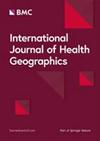Using geographic rescue time contours, point-of-care strategies, and spatial care paths to prepare island communities for global warming, rising oceans, and weather disasters
IF 3
2区 医学
Q2 PUBLIC, ENVIRONMENTAL & OCCUPATIONAL HEALTH
引用次数: 0
Abstract
To perform geographic contour analysis of sea and land ambulance rescue times in an archipelago subject to super typhoons; to design point-of-care testing strategies for medical emergencies and weather disasters made more intense by global warming and rising oceans; and to assess needs for prehospital testing on spatial care paths that accelerate decision making, increase efficiency, improve outcomes, and enhance standards of care in island nations. We performed needs assessments, inspected healthcare facilities, and collected ambulance rescue times from professionals in the Bantayan Archipelago, Philippines. We mapped sea/land ambulance rescue routes and time contours. To reveal gaps, we statistically compared the fastest and slowest patient rescue times from islands/islets and barangays to the District Hospital on Bantayan Island. We developed spatial care paths (the fastest routes to care) for acute myocardial infarction, community care, and infectious diseases. We generated a compendium of prehospital diagnostic testing and integrated outcomes evidence, diagnostic needs, and public health goals to recommend point-of-care strategies that build geographic health resilience. We observed limited access to COVID-19 assays, absence of blood gas/pH testing for critical care support, and spatial gaps in land and airborne rescues that worsened during inclement weather and sea swells. Mean paired differences (slowest-fastest) in ambulance rescue times to the District Hospital for both islands and barangays were significant (P < 0.0001). Spatial care path analysis showed where point-of-care cardiac troponin testing should be implemented for expedited care of acute myocardial infarction. Geospatial strengths comprised distributed primary care that can be facilitated by point-of-care testing, logical interisland transfers for which decision making and triage could be accelerated with onboard diagnostics, and healthcare networks amenable to medical advances in prehospital testing that accelerate treatment. Point-of-care testing should be positioned upstream close to homes and island populations that have prolonged rescue time contours. Geospatially optimized point-of-need diagnostics and distributed prehospital testing have high potential to improve outcomes. These improvements will potentially decrease disparities in mortality among archipelago versus urban dwellers, help improve island public health, and enhance resilience for increasingly adverse and frequent climate change weather disasters that impact vulnerable coastal areas. [350 words].利用地理救援时间等值线、护理点战略和空间护理路径,为岛屿社区应对全球变暖、海洋上升和天气灾害做好准备
对受超强台风影响的群岛的海上和陆地救护车救援时间进行地理等高线分析;针对因全球变暖和海洋上升而变得更加严重的医疗紧急情况和天气灾害,设计护理点检测策略;评估对空间护理路径进行院前检测的需求,以加快决策、提高效率、改善结果并提高岛国的护理标准。我们在菲律宾班塔扬群岛进行了需求评估,视察了医疗设施,并从专业人士那里收集了救护车救援时间。我们绘制了海上/陆地救护车救援路线和时间等值线图。为了揭示差距,我们统计比较了从岛屿/小岛和乡镇到班塔扬岛地区医院最快和最慢的病人抢救时间。我们为急性心肌梗塞、社区护理和传染病制定了空间护理路径(最快的护理路径)。我们编制了院前诊断检测简编,并整合了结果证据、诊断需求和公共卫生目标,以推荐可增强地理健康复原力的护理点策略。我们观察到,COVID-19 检测的获取途径有限,缺乏用于重症监护支持的血气/pH 检测,陆地和空中救援的空间差距在恶劣天气和海啸期间加剧。从岛屿和镇到地区医院的救护车救援时间的平均配对差异(最慢-最快)显著(P < 0.0001)。空间护理路径分析显示,应在哪些地方实施护理点心肌肌钙蛋白检测,以加快急性心肌梗死的护理。地理空间优势包括:护理点检测可促进分布式初级护理;合理的岛屿间转运可通过机载诊断加速决策和分流;医疗保健网络可适应院前检测的医疗进步,从而加速治疗。护理检测点应位于上游,靠近救援时间较长的家庭和岛屿居民。地理空间优化的需求点诊断和分布式院前检测极有可能改善治疗效果。这些改进将有可能减少群岛居民与城市居民之间的死亡率差异,帮助改善岛屿公共卫生,并增强对影响脆弱沿海地区的日益不利和频繁的气候变化天气灾害的抵御能力。[350字]。
本文章由计算机程序翻译,如有差异,请以英文原文为准。
求助全文
约1分钟内获得全文
求助全文
来源期刊

International Journal of Health Geographics
PUBLIC, ENVIRONMENTAL & OCCUPATIONAL HEALTH -
CiteScore
10.20
自引率
2.00%
发文量
17
审稿时长
12 weeks
期刊介绍:
A leader among the field, International Journal of Health Geographics is an interdisciplinary, open access journal publishing internationally significant studies of geospatial information systems and science applications in health and healthcare. With an exceptional author satisfaction rate and a quick time to first decision, the journal caters to readers across an array of healthcare disciplines globally.
International Journal of Health Geographics welcomes novel studies in the health and healthcare context spanning from spatial data infrastructure and Web geospatial interoperability research, to research into real-time Geographic Information Systems (GIS)-enabled surveillance services, remote sensing applications, spatial epidemiology, spatio-temporal statistics, internet GIS and cyberspace mapping, participatory GIS and citizen sensing, geospatial big data, healthy smart cities and regions, and geospatial Internet of Things and blockchain.
 求助内容:
求助内容: 应助结果提醒方式:
应助结果提醒方式:


